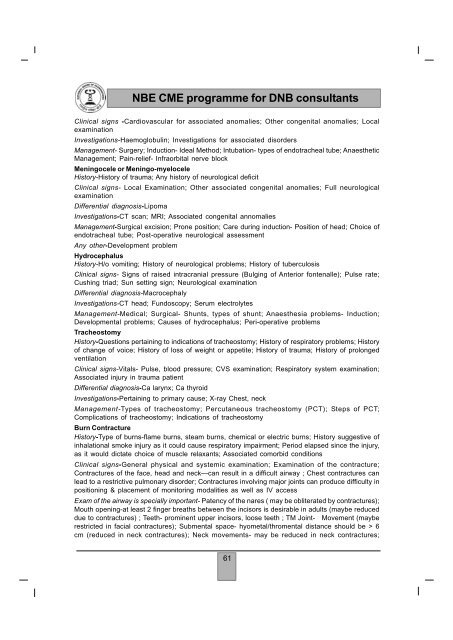NBE CME programme for DNB consultants - National Board Of ...
NBE CME programme for DNB consultants - National Board Of ...
NBE CME programme for DNB consultants - National Board Of ...
You also want an ePaper? Increase the reach of your titles
YUMPU automatically turns print PDFs into web optimized ePapers that Google loves.
<strong>NBE</strong> <strong>CME</strong> <strong>programme</strong> <strong>for</strong> <strong>DNB</strong> <strong>consultants</strong>Clinical signs -Cardiovascular <strong>for</strong> associated anomalies; Other congenital anomalies; LocalexaminationInvestigations-Haemoglobulin; Investigations <strong>for</strong> associated disordersManagement- Surgery; Induction- Ideal Method; Intubation- types of endotracheal tube; AnaestheticManagement; Pain-relief- Infraorbital nerve blockMeningocele or Meningo-myeloceleHistory-History of trauma; Any history of neurological deficitClinical signs- Local Examination; Other associated congenital anomalies; Full neurologicalexaminationDifferential diagnosis-LipomaInvestigations-CT scan; MRI; Associated congenital annomaliesManagement-Surgical excision; Prone position; Care during induction- Position of head; Choice ofendotracheal tube; Post-operative neurological assessmentAny other-Development problemHydrocephalusHistory-H/o vomiting; History of neurological problems; History of tuberculosisClinical signs- Signs of raised intracranial pressure (Bulging of Anterior fontenalle); Pulse rate;Cushing triad; Sun setting sign; Neurological examinationDifferential diagnosis-MacrocephalyInvestigations-CT head; Fundoscopy; Serum electrolytesManagement-Medical; Surgical- Shunts, types of shunt; Anaesthesia problems- Induction;Developmental problems; Causes of hydrocephalus; Peri-operative problemsTracheostomyHistory-Questions pertaining to indications of tracheostomy; History of respiratory problems; Historyof change of voice; History of loss of weight or appetite; History of trauma; History of prolongedventilationClinical signs-Vitals- Pulse, blood pressure; CVS examination; Respiratory system examination;Associated injury in trauma patientDifferential diagnosis-Ca larynx; Ca thyroidInvestigations-Pertaining to primary cause; X-ray Chest, neckManagement-Types of tracheostomy; Percutaneous tracheostomy (PCT); Steps of PCT;Complications of tracheostomy; Indications of tracheostomyBurn ContractureHistory-Type of burns-flame burns, steam burns, chemical or electric burns; History suggestive ofinhalational smoke injury as it could cause respiratory impairment; Period elapsed since the injury,as it would dictate choice of muscle relaxants; Associated comorbid conditionsClinical signs-General physical and systemic examination; Examination of the contracture;Contractures of the face, head and neck—can result in a difficult airway ; Chest contractures canlead to a restrictive pulmonary disorder; Contractures involving major joints can produce difficulty inpositioning & placement of monitoring modalities as well as IV accessExam of the airway is specially important- Patency of the nares ( may be obliterated by contractures);Mouth opening-at least 2 finger breaths between the incisors is desirable in adults (maybe reduceddue to contractures) ; Teeth- prominent upper incisors, loose teeth ; TM Joint- Movement (mayberestricted in facial contractures); Submental space- hyometal/thromental distance should be > 6cm (reduced in neck contractures); Neck movements- may be reduced in neck contractures;61
















